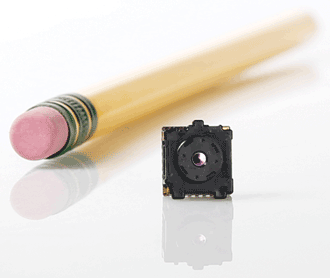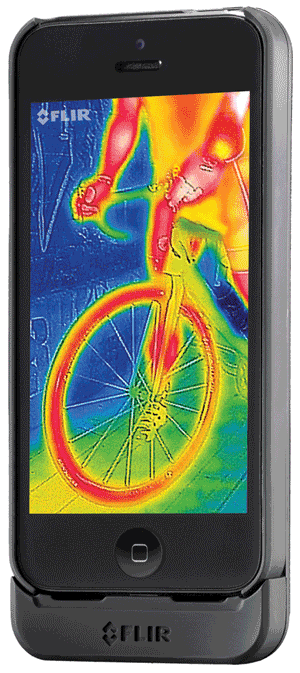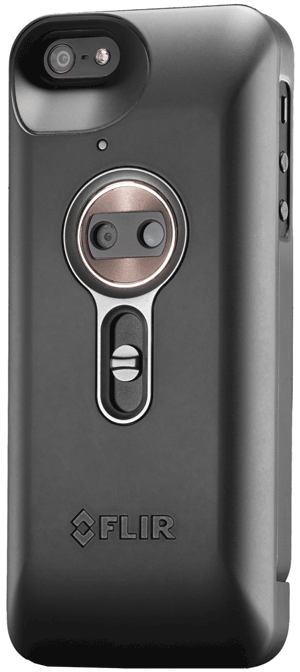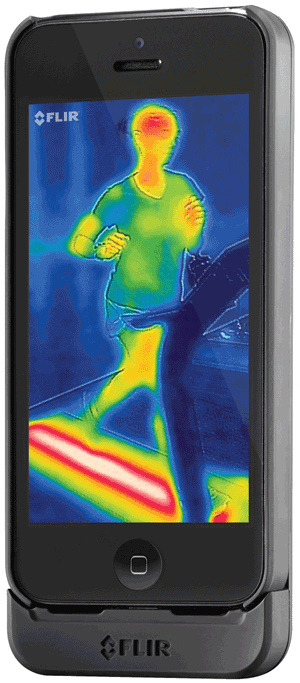Dr. Austin Richards, FLIR Commercial Systems
Personal thermal imaging just got affordable – but the technology can be used in various industries, too.
Thermal imaging is hardly new, but most of us don’t carry thermal imagers in our pockets. Not yet.
But it could happen soon, thanks to a new thermal infrared camera so tiny, low-power and inexpensive that it can fit in a cellphone or other mobile device.
The new micro thermal camera (MTC) represents the latest development in a technological revolution that has seen dramatic reductions in the size, weight, power and cost of thermal imaging cameras over the past 15 years. As an OEM product, the MTC offers engineers around the world low-cost options for equipping handheld and fixed-mount devices with thermal imaging.

The new micro thermal camera is enabled by Flir’s Lepton long-wave infrared sensor.
Historically, the price of personal thermal imagers has been out of reach for the average consumer. Only in the past three years have noncommercial thermal devices fallen below the $2000 price point.
But the new MTC can fit into a smartphone, offering the potential for millions of consumers to carry a thermal imager everywhere they go. In the process, they’ll likely discover novel ways to use these thermal imagers in areas such as personal safety, home maintenance, energy efficiency, mechanical repairs and outdoor recreation.
Beyond personal imaging, however, MTCs are also poised to have a major impact as detectors in industries including building security, climate control and vehicle safety. Passive infrared detectors are nothing new, but they typically use small thermopile arrays that only measure temperature differences within a scene. The new MTC, on the other hand, has enough resolution to actually distinguish between the shapes of humans, animals and objects.

The new micro thermal camera will allow consumers to capture the power of thermal imaging.
The development of the MTC required a significant investment. Some of the key technology advances used in the design included low-cost lenses built in a novel high-volume wafer-level process, wafer-level packaging of sensors to reduce camera size and number of manufacturing steps, high-speed automated camera assembly and calibration with minimal touch labor, and single-chip camera electronics to reduce size and number of interconnections.
Mobile device standard interfacing
One challenge of product development was to make an MTC that would integrate easily into OEM systems. Flir’s MTC, the Lepton, measures only 10 mm high, weighs 0.55 g and consumes less than 150 mW of power. It can run on the low voltages found in standard mobile phones, fits into the standard 32-pin Molex socket used in the mobile phone industry, and uses control and serial video interfaces that are compatible with phone standards.
The control interface is similar to the I2C protocol, and the serial video interface is MIPI compatible, using a D-PHY transmitter to send serial video data and clocks to the host. The video is accessible either via the MIPI interface or as packetized video using SPI.
The first product we developed with the MTC is an accessory for the iPhone that creates a turnkey thermal camera system. Called Flir One, the device comes equipped with both an MTC and a visible light camera. It fits onto the back of the iPhone and displays thermal imagery on the smartphone’s screen.
With a free phone app, users can capture both thermal still images and video, as well as make temperature measurement with a spot meter. The spot meter consists of a 3 × 3-pixel area converted from
digital counts to temperature in Celsius or Fahrenheit temperature units. It is calibrated in absolute temperature units. The temperature calibration also takes into account the emissivity of the material being measured, since that directly affects temperature measurement accuracy.

The Flir One unit fits onto a standard current-generation iPhone.
Onboard image processing in the iPhone app resamples the 80 × 60 thermal image to the normal display resolution. Users conduct a flat-field correction simply by flipping a shutter in front of the MTC with a finger.
Interpreting thermal images generated by the unit and other devices can be challenging if there aren’t obvious “landmarks” to align the thermal image with what users see with their eyes.
To address this, a new patented process digitally blends images taken simultaneously from the visible light camera, and the multispectral dynamic imaging (MSX) MTC takes edge detail from the visible light image and overlays it onto the thermal image. Details such as serial numbers, labels on breakers or the contours of objects become immediately visible when MSX is enabled. This feature spares users from having to photograph scenes with a separate camera, especially for scenes with low contrast.
MSX is particularly important for consumer thermal imaging products, since the user base is not trained or accustomed to interpreting thermal images. Similarly, thermal images of people’s faces often conceal identity. MSX can make a person much more identifiable in thermal.
Additional applications
Thermal imagers are important complements to visible security camera systems because of their ability to capture images at night or during inclement weather. The lenses of visible-light cameras can be
obscured by rain, snow or sun glare – even spiderwebs – and have limited range at night. And, as with human eyes, visible-light cameras require adequate lighting.
While a visible-light security camera will have trouble distinguishing a person wearing dark clothing at night, a thermal camera would immediately pick up that person’s body heat, making his or her presence known. One new security camera called the Mini Bullet is equipped with the same MTC as the Flir One.

Users will likely develop their own individual uses for the MTC, from sports analysis to security and beyond.
The low cost of MTCs will make it possible for manufacturers to create more effective and affordable commercial and consumer-based security systems. And because thermal creates such a reliable image, it’s a good fit for video analytics, which is a computer-based method of studying video streams to identify a range of activity, from pedestrians walking to the movement of vehicles at an intersection.
Thermal detection improved
Beyond its use as an imager, a micro thermal camera is also effective as a detector. Thermal sensors are already used as motion sensors, but nothing on the market compares to the power of MTC. Inexpensive passive infrared sensors, for example, use small thermopile arrays that will trigger an alarm if they sense sudden changes of heat within a scene. These arrays might be as small as 8 × 8 pixels with a total of only 64 pixels available for detection.
The new MTC, on the other hand, has a focal plane array of 80 × 60, for a total of 4800 pixels – enough to capture the shapes of living beings and objects. A sensor with an MTC could be programmed to turn the thermostat down when it doesn’t detect humans present, to lower the windows of a hot car if it senses the presence of a child or family pet, or turn city streetlights on when a pedestrian or car approaches. The next horizon for this technology will be to find ways to increase resolution while maintaining the same miniature form factor.
As with any breakthrough technology, it remains to be seen how industries utilize the power of micro thermal technology. However, with affordable devices in the hands of consumers and commercial users alike, thermal imaging has truly entered the micro age.
Meet the author
Dr. Austin Richards is a senior research scientist at Flir Commercial Systems; email: [email protected].